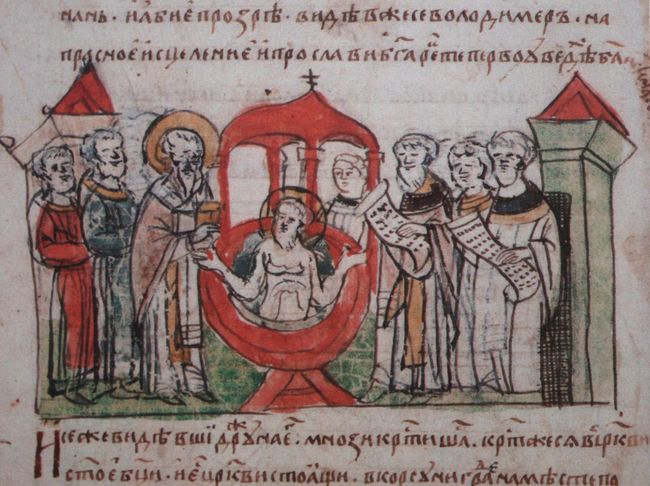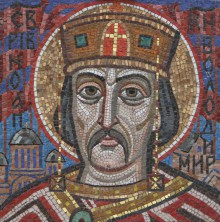The exhibition “Volodymyr the Great – the Founder of the Ukrainian State” at St. Sophia’s Cathedral has caused a sharp debate among art historians, as well as among ordinary Ukrainians. The organizers has presented ancient coins, fragments of the Church of the Tithes walls, icons with Volodymyr’s face, and many pieces of artwork about the Grand Prince envisioned by contemporary artists and sculptors. Volodymyr Rychka, historian, and The Day have visited the exhibition in order to analyze whether it has any historical or artistic value.
A TRIBUTE TO ANNIVERSARY, BUT...
The first question we decided to sort out was how the things on display there represented the prince himself. Rychka had glanced quickly over the small room in search of original exhibits and shrugged disappointedly. “Here we have a private collection,” he points to the artifacts provided by collector Viktor Kyrkevych. “Of course, it’s nice to see them here, but they are not enough.”
The next thing we examined was the wall fragments from the Church of the Tithes. They are authentic, but, according to Rychka, not too relevant to this particular exhibition. “That was the first Christian church in Rus’,” said historian. “Volodymyr had paid it much respect. From Korsun – which, unfortunately, is not mentioned here – he had brought priests and the relics of St. Clement. This laid the foundation of early Christianity in Kyiv. The Historical Museum has a lot of material on the subject, such as the stone circle called omphalius. Volodymyr had been standing on it during worship ceremonies. There are also remains of great paintings and portraits. The words of Christ ‘I am the Alpha and the Omega’ had been laid out in the church. And there was a princely throne.”
According to Rychka, a revived interest to the Grand Prince is a good thing. Most of the works at the exhibition are modern. This shows that artists had not lost their interest to that historical figure. However, whereas the information about Volodymyr can be found across numerous sources, Rychka expected a special kind of atmosphere from this exhibition – which, in his opinion, the organizers failed to achieve.
“It seems that the display is just a tribute to the anniversary. In Soviet times, the poets who wrote poems in honor of particular dates were jokingly referred to as ‘Danish.’ Looks like this exhibition was more intended to formally attend to the issue and failed to sincerely create the focus on history. If one searches the museums of Kyiv, they can create a much more interesting display which would include some originals. For example, they could show a real sribnyk and zlatnyk [silver and gold coins minted in Kyivan Rus’ at the end of the 10th – beginning of the 11th centuries. – Ed.], not just copies like here; they could have set up holograms to serve as libraries. Then, the people would be able to look through the books of Volodymyr’s era, through the Greek chronicles. The exhibition does not show the manner in which Christianity had been adopted, but that fact is very important in understanding of the prince’s figure. There is no information on display on how Volodymyr came to power. Though no direct images of the prince had survived to this day, there are some details which could have given a complete picture to the visitors,” Rychka sums up.
A PRINCE OR A KING?
The exhibition about Volodymyr the Great has as well given rise to many questions from Diana Klochko, art historian. Specifically, she was disturbed by the fact that in most images the prince wears a crown – although he had never been crowned. In that manner he had first been depicted in Soviet times, and hryvnias of the already independent Ukraine kept portraying him as a king.
“It was not Ukrainians who depicted Volodymyr as a king, Russians did it – although it happened in Kyiv, on the wall of St. Volodymyr Cathedral,” says Klochko. “Back then Russia needed to link our past to theirs and place Volodymyr in one line with Rurikovich Dinasty – this could be done only by making him a king. This is our ‘imperial tail’ that extends until now.”
She insists that the images of historical figures must adhere to the established facts. In this regard, Volodymyr Rychka is not so dogmatic.
Since the images of the prince are not preserved, the historian admits the right of interpretation depending on the artist’s imagination, though he himself works hard on his descriptions to reconstruct the image of the Grand Prince as close as possible.
“Images of Volodymyr that we see are works of the authors’ imagination, and it couldn’t be the other way. What we see on hryvnias was created according to my research. We worked with the descriptions of Volodymyr – see his aquiline nose, his strong-willed sight? All these images are based on how Volodymyr was presented at his time. Among the known in vivo images of Prince are his sribnyk and zlatnyk, but they are not too clear,” Rychka explains.

THE BAPTISM OF VOLODYMYR, 988 – A MINIATURE IN THE RADZIWILL CHRONICLE, 15th CENTURY / Photo replica by Mykola TYMCHENKO, The Day
“A discussion on the historical authenticity is normal,” says Oleksandr Zinchenko, adviser to the chairman of the Institute of National Memory. “We are not living in a totalitarian society. When a historical (or a pseudohistorical) image of someone from the past appears, I would not limit its degree of creativity. If we take, for example, our hryvnia, we see a portrait of Volodymyr Sviatoslavovych. If we look the bill of ten zlotys – we see Mieszko, the first baptist of Poland. If we compare these portraits, we can see the fantastic similarity between the two. One can even think that they were brothers. We have this kind of situations occur because those are only schematic representations. The square in front of Notre Dame de Paris has a huge monument to Charles the Great on it – but no one knows how Charles the Great had looked like in reality. In my opinion, all the historical images of ancient times are simulacra.”
The only thing the historians agree upon is that the crown should be removed from the Grand Prince’s head. More so, as it is not a crown at all, it’s a women’s diadem, which, according to the research, was presented to a Volodymyr’s granddaughter by her husband and has nothing to do with Volodymyr himself.
NON-AUTHENTIC THINGS CAN ALSO CAUSE INTEREST
Now the society has a demand on history, the people tend to rethink their cultural heritage, to spread the information about it to the widest audience possible. However, we have yet to achieve the quality of our heritage’s samples, says Diana Klochko.
“Right now, after Maidan, we have a kind of hiatus in the creation of historical narratives, and artists, as well as the benefactors of art, have yet to catch up with the reinterpretation of historical images. We respond to events in a certain way, but our historical memory falls behind the actualization of these events. In such a period we observe the creation of artifacts that often negate the notion of an artistic value. For example, take the design of the monument to Anna Yaroslavna to be installed in Kyiv. The first question is why her? After all she is just one of the daughters, who were married away to Europe, Yaroslav had plenty of them. The focus on her, and the creation of an artifact, in which she is depicted as a five-year girl wearing a crown and holding a book, has genuinely surprised me. It is a kind of monument, in which nothing corresponds to historical facts.”
In the absence of images which would satisfy the artists’ tastes, Klochko argues that we could search for various plastic solutions in implementation of our monuments. But Zinchenko is certain that society is not entirely ready for contemporary art. “We had such kind of a problem with the monument to the Revolution of Dignity heroes,” Zinchenko says. “While there had been a representative of the Heavenly Hundred’s families in the jury, the project met a mixed response among them. Some relatives wanted the monument to look like human beings, like at a cemetery – but this is simply impractical. We are going through the simulacra, because society is often not ready to accept symbolism.”
While the experts argue on the value of the exhibition in question, it has garnered some interest in visitors of St. Sophia. Whereas most of the items on display may not be authentic and somewhat disagree with historical data, they are popular. Perhaps, we are now one step closer to a deeper understanding of the history within every Ukrainian.







